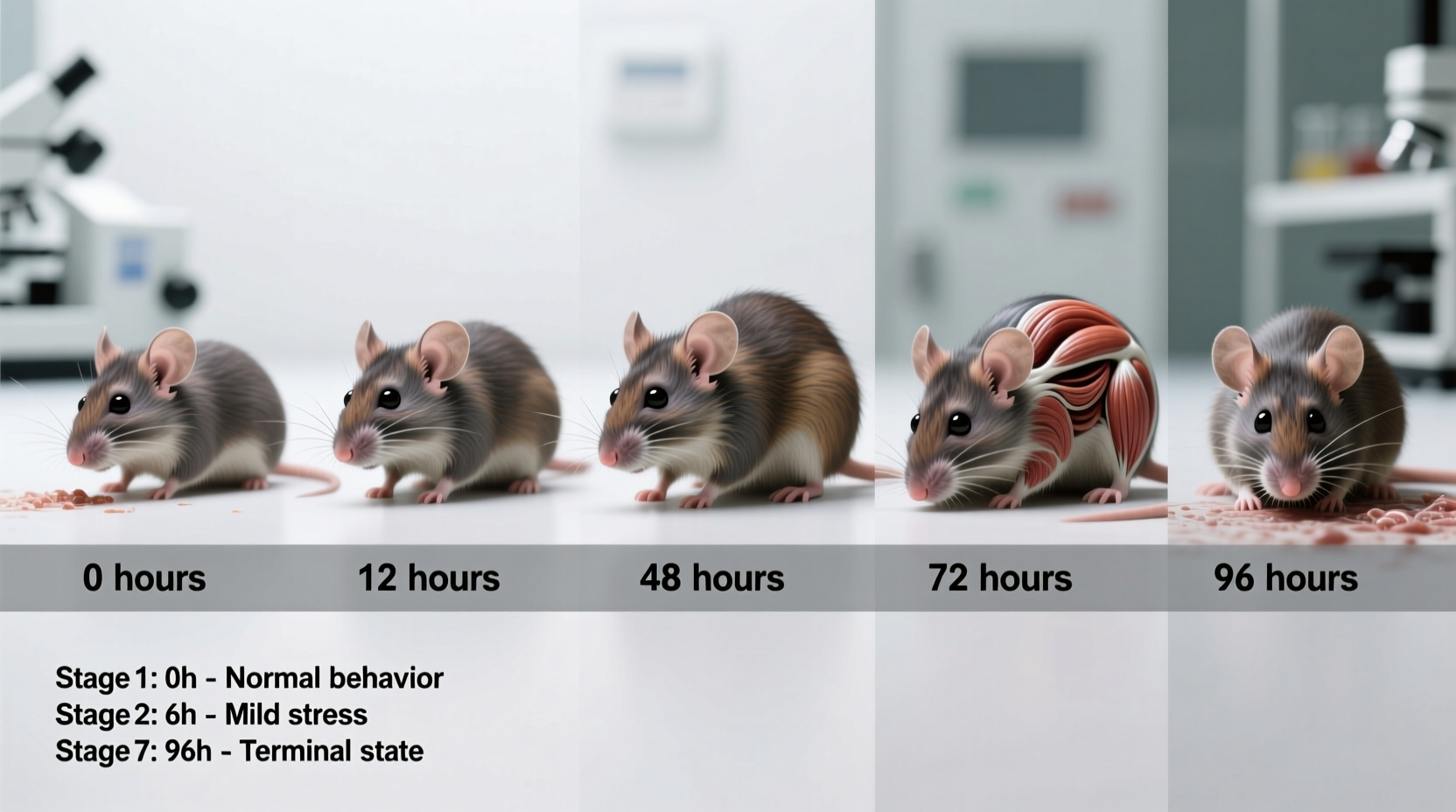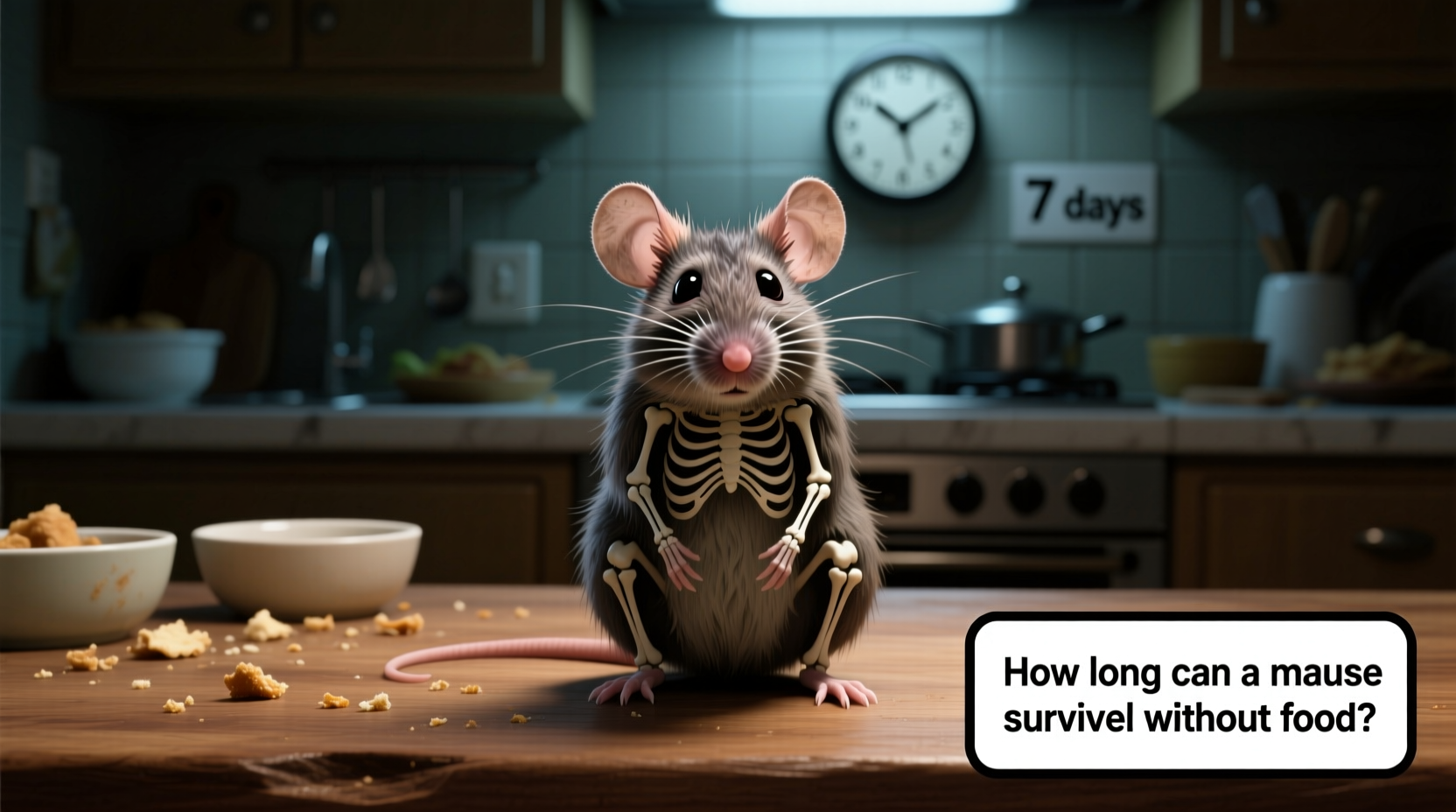Why Mouse Survival Time Matters for Homeowners
If you're dealing with a mouse infestation, knowing how long these rodents can survive without food helps determine effective control strategies. Many homeowners mistakenly believe that simply removing food sources will solve the problem quickly. However, mouse metabolism and survival mechanisms make them remarkably resilient.
Mouse Starvation Timeline: What Science Tells Us
Mice have high metabolic rates due to their small size and rapid heart rate (500-600 beats per minute). This means they need frequent food intake under normal conditions. When deprived of food, their bodies initiate survival mechanisms:
| Time Period | Physiological Changes | Behavioral Changes |
|---|---|---|
| 0-24 hours | Depletion of glycogen stores | Increased foraging activity |
| 24-48 hours | Transition to fat metabolism | Expanded search radius, riskier behavior |
| 48-72 hours | Protein breakdown begins | Reduced activity to conserve energy |
| 72+ hours | Organ function impairment | Severe weakness, minimal movement |
According to research from the University of Kentucky College of Agriculture, adult mice with access to water can survive up to 14 days without food under ideal temperature conditions (68-77°F). However, in typical home environments with temperature fluctuations, the survival window narrows considerably.
Water vs. Food: Which Matters More for Mouse Survival?
Contrary to popular belief, water access dramatically extends mouse survival time without food. The Centers for Disease Control and Prevention (CDC) notes that mice can survive only 2-3 days without water, but up to two weeks without food if water is available. This explains why eliminating water sources is equally important in pest control strategies.

Factors That Shorten Mouse Survival Without Food
Several environmental factors significantly reduce how long mice can survive without food:
- Temperature extremes - Below 50°F or above 85°F reduces survival time by 30-50% according to University of Minnesota Extension
- Age and health - Juvenile mice survive half as long as healthy adults
- Stress levels - Trapped or hunted mice deplete energy reserves faster
- Alternative food sources - Mice will consume non-food items like soap, glue, or stored seeds
Practical Implications for Effective Mouse Control
Understanding mouse starvation timelines informs more effective pest management:
Sealing Food Sources Alone Isn't Enough
While eliminating food access is important, it won't solve an infestation within days. A comprehensive approach must address both food AND water sources. Mice can obtain moisture from condensation, leaky pipes, and even high-moisture foods like pet food.
The 3-Day Rule for Trapped Mice
If you've trapped mice, humane guidelines recommend checking traps every 24 hours. Mice trapped without food or water will suffer significantly after 48 hours. The American Society for the Prevention of Cruelty to Animals (ASPCA) emphasizes that leaving trapped mice for extended periods constitutes unnecessary suffering.
Prevention Through Environmental Management
Instead of relying on starvation, focus on prevention:
- Seal entry points larger than 1/4 inch
- Fix plumbing leaks and eliminate standing water
- Store food in airtight containers
- Maintain indoor temperatures below 65°F when possible
Mouse Metabolism: Why They Need Frequent Feeding
Mice consume 10-15% of their body weight daily (about 3-5 grams of food). Their rapid metabolism requires frequent eating to maintain energy levels. Unlike larger mammals, mice cannot store significant fat reserves. When food becomes scarce, they enter a state of reduced activity to conserve energy, but this adaptation only extends survival by a few days.
Research published in the Journal of Mammalogy shows that mice in laboratory conditions with water but no food experienced significant weight loss (15-20%) within 48 hours, with survival becoming unlikely after 96 hours for older specimens.
Humane Considerations in Mouse Control
Understanding mouse starvation timelines isn't just practical—it's ethical. Gradual starvation causes significant suffering as mice experience:
- Severe dehydration symptoms after 48 hours
- Muscle wasting and weakness
- Impaired organ function
- Increased vulnerability to disease
Wildlife experts recommend using snap traps or working with professional pest control services rather than relying on starvation methods. If you discover a trapped mouse that's still alive, contact local wildlife rehabilitation services for humane removal options.
How long can a mouse survive without food but with water?
Mice can typically survive 4-7 days without food when water is available. Under ideal laboratory conditions, some may survive up to 14 days, but in typical home environments with temperature fluctuations, most won't survive beyond 7 days.
What happens to a mouse when it doesn't eat for several days?
After 24-48 hours without food, mice begin using fat reserves. By 72 hours, they start breaking down muscle tissue. Symptoms include weakness, reduced activity, dehydration, and impaired organ function. Death typically occurs from multiple organ failure after 4-7 days without food.
Can mice die from starvation in walls?
Yes, mice trapped in walls without access to food or water will typically die within 2-4 days. However, they often find alternative food sources like insulation materials, stored seeds, or even other dead rodents, which can extend their survival time significantly.
How long do mice survive in glue traps without food?
Mice caught in glue traps typically survive 3-5 days without food or water. The stress of being trapped accelerates dehydration and energy depletion. Humane pest control guidelines strongly discourage the use of glue traps due to the prolonged suffering they cause.











 浙公网安备
33010002000092号
浙公网安备
33010002000092号 浙B2-20120091-4
浙B2-20120091-4